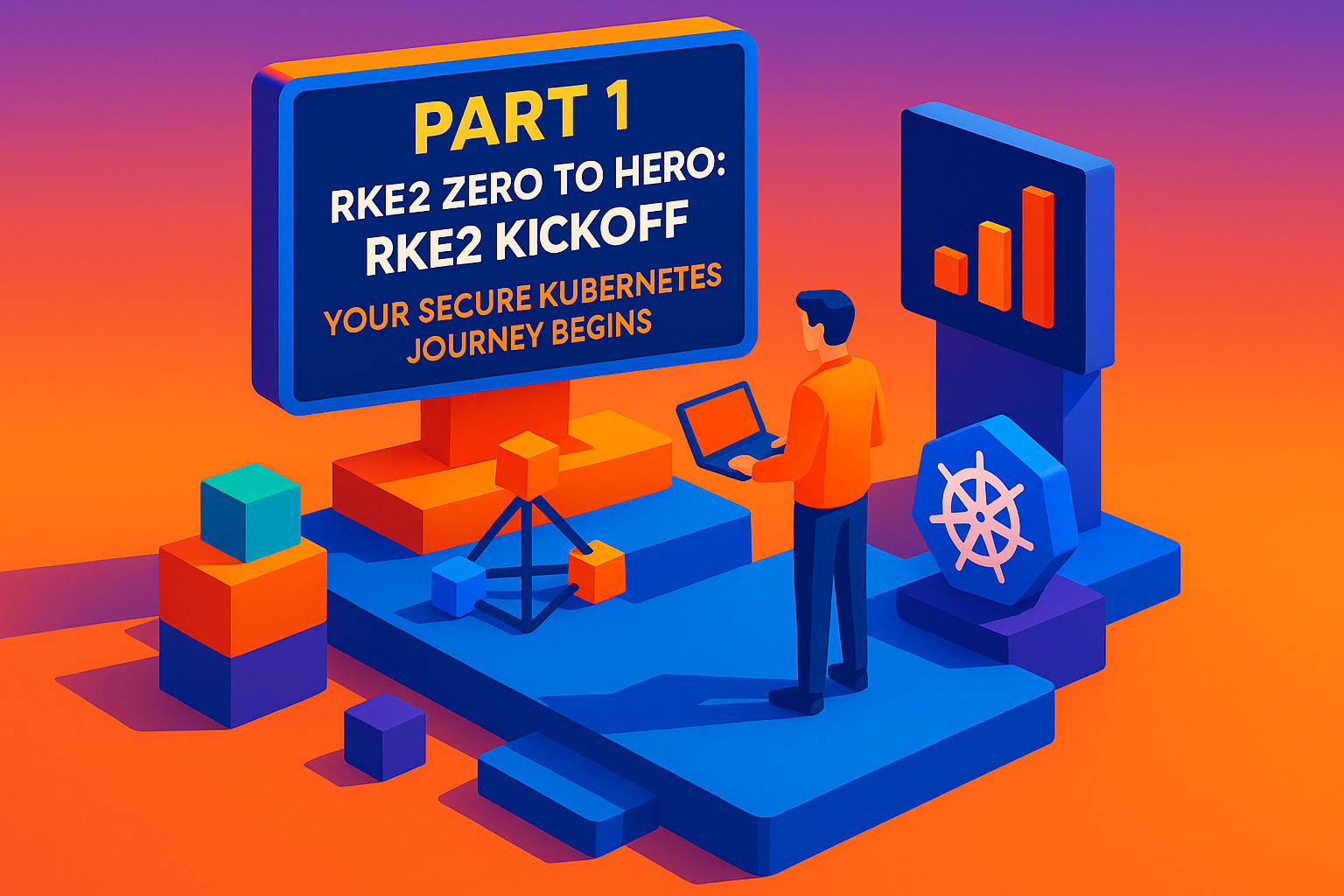Part 1 - RKE2 Zero to Hero: RKE2 Kickoff - Your Secure Kubernetes Journey Begins

Welcome to the first installment of our "RKE2: Zero to Hero" series, where we'll transform you from a Kubernetes newcomer into an RKE2 virtuoso faster than you can say "container orchestration." If you've ever stared at a vanilla Kubernetes installation guide and felt like you were reading ancient hieroglyphics, you're in the right place. RKE2 is here to make your life significantly easier, your clusters significantly more secure, and your compliance officers significantly happier.
Understanding RKE2: The Government-Grade Kubernetes Distribution
Rancher Kubernetes Engine 2 (RKE2) represents the evolution of container orchestration for organizations that take security seriously. Originally known as "RKE Government," this distribution was specifically engineered to meet the stringent requirements of U.S. Federal Government agencies, but don't let that intimidate you. Think of RKE2 as Kubernetes wearing a three-piece suit and carrying a security clearance.
RKE2 is fundamentally a fully conformant Kubernetes distribution that focuses on security and compliance within demanding environments. Unlike your standard Kubernetes installation that requires you to assemble various components like a particularly complex IKEA bookshelf, RKE2 comes pre-configured with defaults that allow clusters to pass the CIS Kubernetes Benchmark with minimal operator intervention. This means you can achieve enterprise-grade security without spending weeks reading documentation and tweaking configuration files.
The distribution provides several critical security enhancements out of the box. It enables FIPS 140-2 compliance for cryptographic operations and regularly scans components for CVEs using Trivy in the build pipeline. For organizations operating in regulated industries such as healthcare, finance, or government sectors, RKE2 offers the confidence that comes with DISA STIG validation and comprehensive security hardening.
RKE2 vs. The Competition: Understanding the Differences
To appreciate what makes RKE2 special, we need to understand how it compares to its siblings in the Kubernetes family tree. The relationship between RKE2, K3s, and vanilla Kubernetes is like comparing a luxury sedan, a sports car, and a DIY kit car – they'll all get you where you're going, but the experience differs dramatically.
RKE2 vs. Standard Kubernetes
Standard Kubernetes requires significant manual configuration and component management. You'll need to separately install and configure etcd, the API server, scheduler, controller manager, and various networking components. RKE2 eliminates this complexity by packaging everything into a cohesive distribution that launches control plane components as static pods managed by the kubelet. This approach provides better observability since control plane logs can be collected through normal Kubernetes tools.
Unlike vanilla Kubernetes installations that often rely on Docker, RKE2 uses containerd as its embedded container runtime. This eliminates Docker dependencies while providing a more stable and secure foundation for your containers. The distribution also maintains close alignment with upstream Kubernetes, ensuring compatibility with standard tools and practices.
RKE2 vs. K3s: Choosing Your Fighter
The comparison between RKE2 and K3s often confuses newcomers since both distributions come from the same company and share similar installation simplicity. However, their target use cases differ significantly. K3s is designed as a lightweight distribution optimized for edge computing, IoT devices, and resource-constrained environments. It achieves this by replacing etcd with SQLite by default and removing certain cloud provider integrations.
RKE2, conversely, inherits the usability and ease-of-operations from K3s while maintaining closer alignment with upstream Kubernetes. Where K3s diverged from upstream to optimize for edge deployments, RKE2 stays faithful to standard Kubernetes patterns. This makes RKE2 ideal when you need the security and compliance features without sacrificing compatibility with enterprise tools and practices.
The security differences are particularly noteworthy. While K3s is CNCF-certified and production-ready, it isn't secured by default to the same degree as RKE2. RKE2 comes pre-configured to meet CIS Kubernetes Benchmarks and includes additional hardening measures that make it suitable for environments with strict security requirements.
Ideal Use Cases for RKE2
RKE2 shines in scenarios where security, compliance, and operational simplicity intersect. Government agencies and defense contractors represent the obvious use cases, given RKE2's DISA STIG certification and FIPS 140-2 compliance. However, the distribution's benefits extend far beyond federal environments.
Financial services organizations appreciate RKE2's robust security posture and compliance capabilities. Healthcare organizations benefit from the enhanced security controls needed to protect sensitive patient data. Any organization operating in a regulated industry where audit trails, security benchmarks, and compliance frameworks matter will find RKE2's out-of-the-box security configurations invaluable.
Multi-cloud and hybrid cloud deployments represent another sweet spot for RKE2. The distribution's infrastructure independence means you can deploy consistent Kubernetes clusters across different cloud providers or on-premises environments without worrying about vendor lock-in. This flexibility proves particularly valuable for organizations pursuing multi-cloud strategies or planning eventual cloud migrations.
Development and CI/CD environments also benefit from RKE2's simplified deployment model. Teams can quickly spin up consistent Kubernetes environments for testing and development without the complexity associated with vanilla Kubernetes installations. The automated provisioning capabilities and straightforward upgrade paths make RKE2 an excellent choice for organizations that need to manage multiple clusters efficiently.
Getting Your Hands Dirty: Installing RKE2
Now for the moment you've been waiting for – actually installing RKE2. If you've previously wrestled with kubeadm or attempted to install Kubernetes "the hard way," you'll appreciate RKE2's refreshingly straightforward approach. The entire process involves three commands and significantly less swearing than traditional Kubernetes installations.
Prerequisites and Preparation
Before diving into the installation, ensure your environment meets the basic requirements. You'll need a Linux system with root access or sudo privileges. If NetworkManager is installed and enabled on your host, configure it to ignore CNI-managed interfaces to prevent networking conflicts. For systems with AppArmor support, ensure the AppArmor tools are installed via the apparmor-parser package.
The beauty of RKE2 lies in its minimal dependencies. Unlike RKE1, which required Docker, RKE2 bundles everything it needs, including the containerd runtime. This self-contained approach eliminates the dependency management headaches that plague many Kubernetes installations.
The Installation Process
RKE2 provides an installation script that handles the heavy lifting for systemd-based systems. This script downloads the appropriate binaries, configures the systemd service, and sets up the basic directory structure. The installation process is surprisingly mundane, which is exactly what you want when deploying production infrastructure.
Execute the installation script with the following command:
curl -sfL https://get.rke2.io | sh -
This command downloads and runs the RKE2 installation script, which installs the rke2-server service and the rke2 binary. The script must run with root privileges due to its system-level modifications. Don't worry about the root requirement – this is standard for container runtime installations and Kubernetes components.
Once the installation completes, enable the RKE2 server service to ensure it starts automatically after system reboots:
systemctl enable rke2-server.service
Finally, start the service to initialize your RKE2 cluster:
systemctl start rke2-server.service
If you're curious about what's happening behind the scenes during startup, you can follow the service logs:
journalctl -u rke2-server -f
Post-Installation Configuration
After the service starts successfully, RKE2 creates several important files and directories. The kubeconfig file is written to /etc/rancher/rke2/rke2.yaml, which you'll use to authenticate with your new cluster. Additional utilities including kubectl, crictl, and ctr are installed in /var/lib/rancher/rke2/bin/, though these aren't added to your system PATH by default.
Two cleanup scripts, rke2-killall.sh and rke2-uninstall.sh, are also installed for cluster maintenance and removal. These scripts prove invaluable when you need to completely reset your cluster or remove RKE2 from your system.
Verifying Your Installation
With RKE2 installed and running, it's time to verify that everything works correctly. This verification process involves configuring kubectl access and confirming that your cluster components are healthy.
Configuring kubectl Access
The kubectl utility needs to know how to authenticate with your RKE2 cluster. You can accomplish this either by setting the KUBECONFIG environment variable or by copying the kubeconfig file to the default location.
For a persistent configuration, set the KUBECONFIG environment variable:
export KUBECONFIG=/etc/rancher/rke2/rke2.yaml
Alternatively, you can specify the kubeconfig path directly in your kubectl commands:
kubectl --kubeconfig /etc/rancher/rke2/rke2.yaml get nodes
For convenience, many administrators copy the kubeconfig file to the default kubectl location:
mkdir -p ~/.kube
cp /etc/rancher/rke2/rke2.yaml ~/.kube/config
Testing Cluster Functionality
With kubectl configured, verify that your cluster is operational by checking the node status:
kubectl get nodes
A healthy single-node RKE2 cluster should show one node in the "Ready" state with the "control-plane" and "master" roles. If your node appears in a "NotReady" state, wait a few minutes for all components to initialize fully.
Check the status of system pods to ensure core Kubernetes components are running correctly:
kubectl get pods --all-namespaces
You should see pods for etcd, the API server, scheduler, controller manager, and networking components all in "Running" status. This comprehensive pod listing confirms that your RKE2 installation is functioning properly and ready for workload deployment.
Remote Access Configuration
If you plan to manage your RKE2 cluster from a remote machine, you'll need to modify the kubeconfig file. Copy /etc/rancher/rke2/rke2.yaml to your remote machine and save it as ~/.kube/config. Replace the 127.0.0.1 server address with your RKE2 server's actual IP address or hostname. After this modification, kubectl from your remote machine can manage the RKE2 cluster seamlessly.
What's Next in Your RKE2 Journey
Congratulations! You've successfully deployed your first RKE2 cluster and verified its functionality. You now have a secure, government-grade Kubernetes distribution running and ready for action. Your single-node cluster provides an excellent foundation for learning RKE2 concepts and experimenting with Kubernetes workloads.
In our next installment, "Scaling Up: Multi-Node RKE2 Clusters Made Easy," we'll expand your cluster's capabilities by adding additional nodes. You'll learn the distinction between server and agent nodes, master the token-based joining process, and discover how to build resilient multi-node clusters that can handle production workloads. We'll also cover essential troubleshooting techniques for those inevitable moments when nodes decide to be difficult.
Your journey from RKE2 novice to expert has begun, and you're already past the most challenging hurdle – getting started. The foundation you've built today will support increasingly sophisticated deployments as we progress through this series. Keep that cluster running, and we'll see you in Part 2 where the real fun begins.

